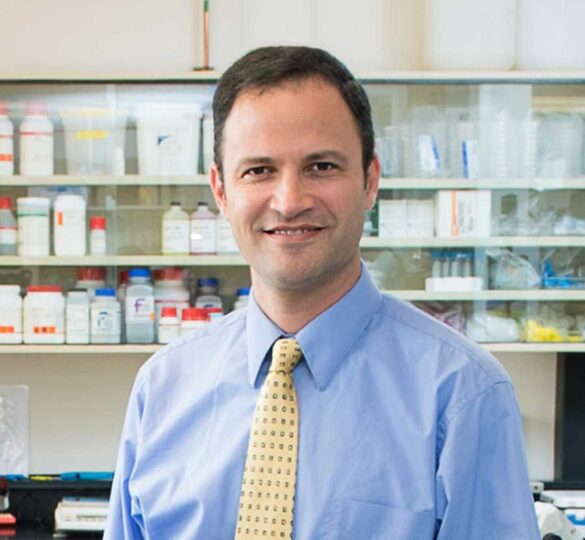Dr. Jeffrey Goldberg Discusses Glaucoma Research Foundation’s Catalyst for a Cure and a New Surgical Implant Option for Patients

Dr. Goldberg's research is directed at neuroprotection and regeneration of retinal ganglion cells and the optic nerve, as well as stem cell and nanotherapeutic approaches to repair damaged eyes.
Dr. Jeffrey Goldberg is a Stanford University Professor of Ophthalmology and Chair of Ophthalmology at the Byers Eye Institute. Goldberg’s clinical efforts are focused on medical and surgical treatments for glaucoma, retinal and optic nerve diseases, and cataracts.
The research he has been spearheading is directed at neuroprotection and regeneration of retinal ganglion cells and the optic nerve, as well as stem cell and nanotherapeutic approaches to repair damaged eyes.
Q: How did you first become interested in glaucoma?
Twenty years ago, I was a graduate student in neuroscience, studying optic nerve regeneration at Stanford. I was finishing my Ph.D on regeneration failure in the central nervous system when I discovered ophthalmology. I recognized that irreversibility of blinding eye diseases like glaucoma was due to the central nervous system’s failure to regenerate. I wanted to participate in finding the answer to a major problem in basic neuroscience and clinical ophthalmology.
Q: Your research is moving from the lab into clinical studies. Can you walk us through the process so far?
Yes, we have been transitioning over the last couple of years, working with biomarker candidates as well as therapeutic candidates to either restore vision lost to glaucoma, or protect patient’s vision from the progression of the disease. In a Phase One trial, we worked with eleven patients, studying the action of Ciliary Neurotrophic Factor (CNTF), a protein that promotes both neuroprotection and regeneration in models of glaucoma. We found some indications of efficacy, and that was exciting enough to lead to a Phase Two trial for CNTF for glaucoma.
Recent breakthroughs from the Glaucoma Research Foundation Catalyst for a Cure labs that are being transferred to the clinic, include the discovery that certain types of retinal ganglion cells degenerate earlier, that mitochondria show early signs of damage in response to glaucoma, and new optical engineering being developed to noninvasively measure metabolism, structure, and function.
Q: What makes this CNTF surgical implant different or unique, and do you have hopes that it will address some issues that other similar treatments will not?
Current medical and surgical treatments for glaucoma are normally targeting lowering of intraocular pressure. These surgical CNTF implants target regenerating the optic nerve and protecting the neurons in the back of the eye. In animal models, CNTF has been shown to protect neurons from dying. In other words, we’re not just lowering eye pressure, we’re protecting nerve cells from degeneration. We also have a few other potential treatments underway, focusing on stem cells and gene therapies, but they are still in the laboratory, and we are working hard to get them into human testing.
Q: What can you tell us about your collaborators, Dr. Alfredo Dubra, Dr. Vivek Srinivasan, and Dr. Andrew Huberman, and the role Glaucoma Research Foundation plays in making it all happen?
All four of us are involved in GRF’s Catalyst for a Cure program. Vivek and Alfredo are optical engineers working on ways to better measure retinal ganglion cells’ structure and function, using noninvasive imaging. Andrew is a premier neuroscientist studying the earliest retinal ganglion cell changes that take place in response to glaucoma, as well as ways to promote retinal cell survival and regeneration.
Thanks to GRF, we have a unique opportunity to bring together scientists who are working in disparate areas of science to collaborate and open up new fields that they wouldn’t have had the resources to get into without the support of the foundation. That support opens up new collaborative directions, allowing us to take risks and go after big questions.
Q: What would you say to someone who has glaucoma and is worried about the future of available treatments? What hope or caution would you give them?
There is a lot to be hopeful for. There are a lot of promising drug candidates in the laboratory now. There are also new biomarkers, ways of measuring disease, that are candidates for human testing. The next few years will be exciting as we collect data on their efficacy and on new first-candidate therapeutics.
Q: What would you say to someone looking at the GRF website to find out about new treatment developments and is thinking about contributing. Why is funding so important to the glaucoma research community, and why should individuals help by donating?
The National Institutes of Health, the National Eye Institute, the Veteran’s Administration, and the Department of Defense, for example, are excellent at funding fundamental basic science research and the earliest stages of translational research. Meanwhile, biotech or pharmaceutical companies and venture capitalists often come in to fund the final stages of product development. But it is really hard securing funding for high-risk high-reward research, and for transitioning promising research out of the lab and applying it to human testing. Glaucoma Research Foundation is one of the few sources of funding available for that type of research and by supporting GRF, you help us take our work from the lab to the clinic, which is a critical step towards finding a cure. That is why GRF funding is so important.
Research funded by people like you supports researchers like Dr. Jeffrey Goldberg. Your generous donation to Glaucoma Research Foundation goes to support those developing the next generation of glaucoma programs, treatments, and innovations.
First posted on March 16, 2017; Reviewed on May 12, 2022.